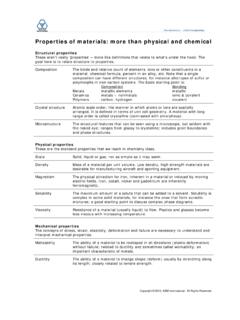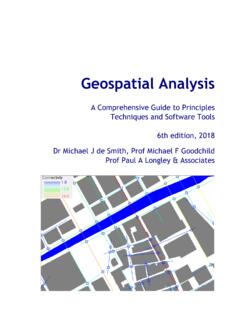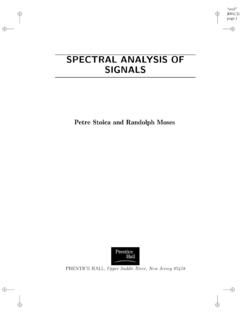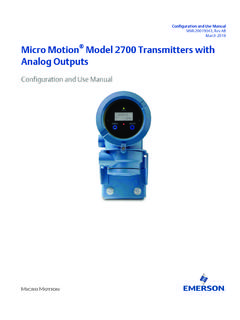Transcription of Introduction to Composite Materials - ASM International
1 chapter 1 Introduction to Composite MaterialsStructural Composite Materials Copyright 2010, ASM International Campbell All rights 1 Introduction to Composite MaterialsA Composite MAterIAl can be defined as a combination of two or more Materials that results in better properties than those of the indi-vidual components used alone. In contrast to metallic alloys, each material retains its separate chemical, physical, and mechanical properties. the two constituents are a reinforcement and a matrix. the main advantages of Composite ma-terials are their high strength and stiffness, com-bined with low density , when compared with bulk Materials , allowing for a weight reduction in the finished reinforcing phase provides the strength and stiffness. In most cases, the reinforcement is harder, stronger, and stiffer than the matrix. the reinforcement is usually a fiber or a particulate. particulate composites have dimensions that are approximately equal in all directions.
2 They may be spherical, platelets, or any other regular or ir-regular geometry. particulate composites tend to be much weaker and less stiff than continuous-fiber composites, but they are usually much less expensive. particulate reinforced composites usu-ally contain less reinforcement (up to 40 to 50 volume percent) due to processing difficulties and brittleness. A fiber has a length that is much greater than its diameter. the length-to-diameter (l/d) ratio is known as the aspect ratio and can vary greatly. Continuous fibers have long aspect ratios, while discontinuous fibers have short aspect ratios. Continuous-fiber composites normally have a preferred orientation, while discontinuous fibers generally have a random orientation. examples of continuous reinforcements include unidirec-tional, woven cloth, and helical winding (Fig. ), while examples of discontinuous rein-forcements are chopped fibers and random mat (Fig. ). Continuous-fiber composites are often made into laminates by stacking single sheets of continuous fibers in different orienta-tions to obtain the desired strength and stiffness properties with fiber volumes as high as 60 to 70 percent.
3 Fibers produce high-strength com-posites because of their small diameter; they con-tain far fewer defects (normally surface defects) compared to the material produced in bulk. As a general rule, the smaller the diameter of the fiber, the higher its strength, but often the cost increases as the diameter becomes smaller. In addition, smaller-diameter high-strength fibers have greater flexibility and are more amenable to fabrication processes such as weaving or forming over radii. typical fibers include glass, aramid, and carbon, which may be continuous or discontinuous. the continuous phase is the matrix, which is a polymer, metal, or ceramic. polymers have low strength and stiffness, metals have intermediate strength and stiffness but high ductility, and ce-ramics have high strength and stiffness but are brittle. the matrix (continuous phase) performs several critical functions, including maintaining the fibers in the proper orientation and spacing and protecting them from abrasion and the envi-ronment.
4 In polymer and metal matrix compos-ites that form a strong bond between the fiber and the matrix, the matrix transmits loads from the matrix to the fibers through shear loading at the interface. In ceramic matrix composites, the objective is often to increase the toughness rather than the strength and stiffness; therefore, a low interfacial strength bond is type and quantity of the reinforcement determine the final properties. Figure shows that the highest strength and modulus are ob-tained with continuous-fiber composites. there is a practical limit of about 70 volume percent rein-forcement that can be added to form a Composite . At higher percentages, there is too little matrix to support the fibers effectively. the theoretical (#05287G)2 / Structural Composite Materialsstrength of discontinuous-fiber composites can approach that of continuous-fiber composites if their aspect ratios are great enough and they are aligned, but it is difficult in practice to main-tain good alignment with discontinuous fibers.
5 Discontinuous-fiber composites are normally somewhat random in alignment, which dramati-cally reduces their strength and modulus. How-ever, discontinuous-fiber composites are gen-erally much less costly than continuous-fiber composites. therefore, continuous-fiber com-posites are used where higher strength and stiff-ness are required (but at a higher cost), and discontinuous-fiber composites are used where cost is the main driver and strength and stiffness are less the reinforcement type and the matrix af-fect processing. the major processing routes for polymer matrix composites are shown in Fig. two types of polymer matrices are shown: ther-mosets and thermoplastics. A thermoset starts as a low-viscosity resin that reacts and cures during processing, forming an intractable solid. A ther-moplastic is a high-viscosity resin that is pro-cessed by heating it above its melting tempera-ture. Because a thermoset resin sets up and cures during processing, it cannot be reprocessed by reheating.
6 By comparison, a thermoplastic can be reheated above its melting temperature for ad-ditional processing. there are processes for both classes of resins that are more amenable to dis-continuous fibers and others that are more ame-nable to continuous fibers. In general, because metal and ceramic matrix composites require very high temperatures and sometimes high pres-sures for processing, they are normally much more expensive than polymer matrix composites. However, they have much better thermal stabil-ity, a requirement in applications where the com-posite is exposed to high book will deal with both continuous and discontinuous polymer, metal, and ceramic matrix Fig. reinforcement typesChapter 1: Introduction to Composite Materials / 3 Fig. of reinforcement type and quantity on Composite performanceFig. polymer matrix Composite fabrication processes4 / Structural Composite Materialscomposites, with an emphasis on continuous- fiber, high-performance polymer composites.
7 Isotropic, anisotropic, and Orthotropic MaterialsMaterials can be classified as either isotropic or anisotropic. Isotropic Materials have the same material properties in all directions, and normal loads create only normal strains. By compari-son, anisotropic Materials have different mate-rial properties in all directions at a point in the body. there are no material planes of symmetry, and normal loads create both normal strains and shear strains. A material is isotropic if the prop-erties are independent of direction within the material. For example, consider the element of an iso-tropic material shown in Fig. If the material is loaded along its 0 , 45 , and 90 directions, the modulus of elasticity (E) is the same in each direction (E0 = E45 = E90 ). However, if the material is anisotropic (for example, the compos-ite ply shown in Fig. ), it has properties that vary with direction within the material. In this example, the moduli are different in each direc-tion (E0 E45 E90 ).
8 While the modulus of elasticity is used in the example, the same depen-dence on direction can occur for other material properties, such as ultimate strength, poisson s ratio, and thermal expansion Materials , such as metals and polymers, are normally treated as isotropic Materials , while composites are treated as anisotropic. However, even bulk Materials such as metals can become anisotropic for example, if they are highly cold worked to produce grain alignment in a certain the unidirectional fiber-reinforced Composite ply (also known as a lamina) shown in Fig. the coordinate system used to de-scribe the ply is labeled the 1-2-3 axes. In this case, the 1-axis is defined to be parallel to the fibers (0 ), the 2-axis is defined to lie within the plane of the plate and is perpendicular to the fi-bers (90 ), and the 3-axis is defined to be normal Fig. of isotropic material under stressChapter 1: Introduction to Composite Materials / 5 Fig.
9 Of Composite ply material under stressFig. angle definition6 / Structural Composite Materialsto the plane of the plate. the 1-2-3 coordinate system is referred to as the principal material coordinate system. If the plate is loaded parallel to the fibers (one- or zero-degree direction), the modulus of elasticity E11 approaches that of the fibers. If the plate is loaded perpendicular to the fibers in the two- or 90-degree direction, the modulus E22 is much lower, approaching that of the relatively less stiff matrix. Since E11 >> E22 and the modulus varies with direction within the material, the material is are a subclass of anisotropic mate-rials that are classified as orthotropic. ortho-tropic Materials have properties that are different in three mutually perpendicular directions. they have three mutually perpendicular axes of sym-metry, and a load applied parallel to these axes produces only normal strains. However, loads that are not applied parallel to these axes produce both normal and shear strains.
10 Therefore, ortho-tropic mechanical properties are a function of orientation. Consider the unidirectional Composite shown in the upper portion of Fig. , where the unidi-rectional fibers are oriented at an angle of 45 de-grees with respect to the x-axis. In the small, isolated square element from the gage region, be-cause the element is initially square (in this ex-ample), the fibers are parallel to diagonal AD of the element. In contrast, fibers are perpendicular to diagonal BC. this implies that the element is stiffer along diagonal AD than along diagonal BC. When a tensile stress is applied, the square element deforms. Because the stiffness is higher along diagonal AD than along diagonal BC, the length of diagonal AD is not increased as much as that of diagonal BC. therefore, the initially square element deforms into the shape of a par-allelogram. Because the element has been dis-torted into a parallelogram, a shear strain gxy is induced as a result of coupling between the axial strains exx and the fibers are aligned parallel to the direc-tion of applied stress, as in the lower portion of Fig.

















